3D Printing Technology: A Report for Sonix Computers' Growth
VerifiedAdded on 2021/06/14
|13
|3115
|284
Report
AI Summary
This report, prepared for Sonix Computers, investigates the applications of 3D printing technology across various industries, including manufacturing and medicine. It begins with an executive summary outlining the increasing use of 3D printing in prototyping and production, emphasizing its advantages such as reduced production time, lower waste, and increased flexibility. The report details the modeling, printing, and finishing processes involved in 3D printing and explores its applications in automotive, aerospace, construction, and biomedical engineering. The report also analyzes how Sonix Computers can leverage 3D printing for business expansion, focusing on construction, architecture, and mass customization to enhance product offerings and customer satisfaction. Finally, the report concludes with recommendations for adopting 3D printing to improve profitability and gain a competitive edge in the market. The report is available on Desklib.
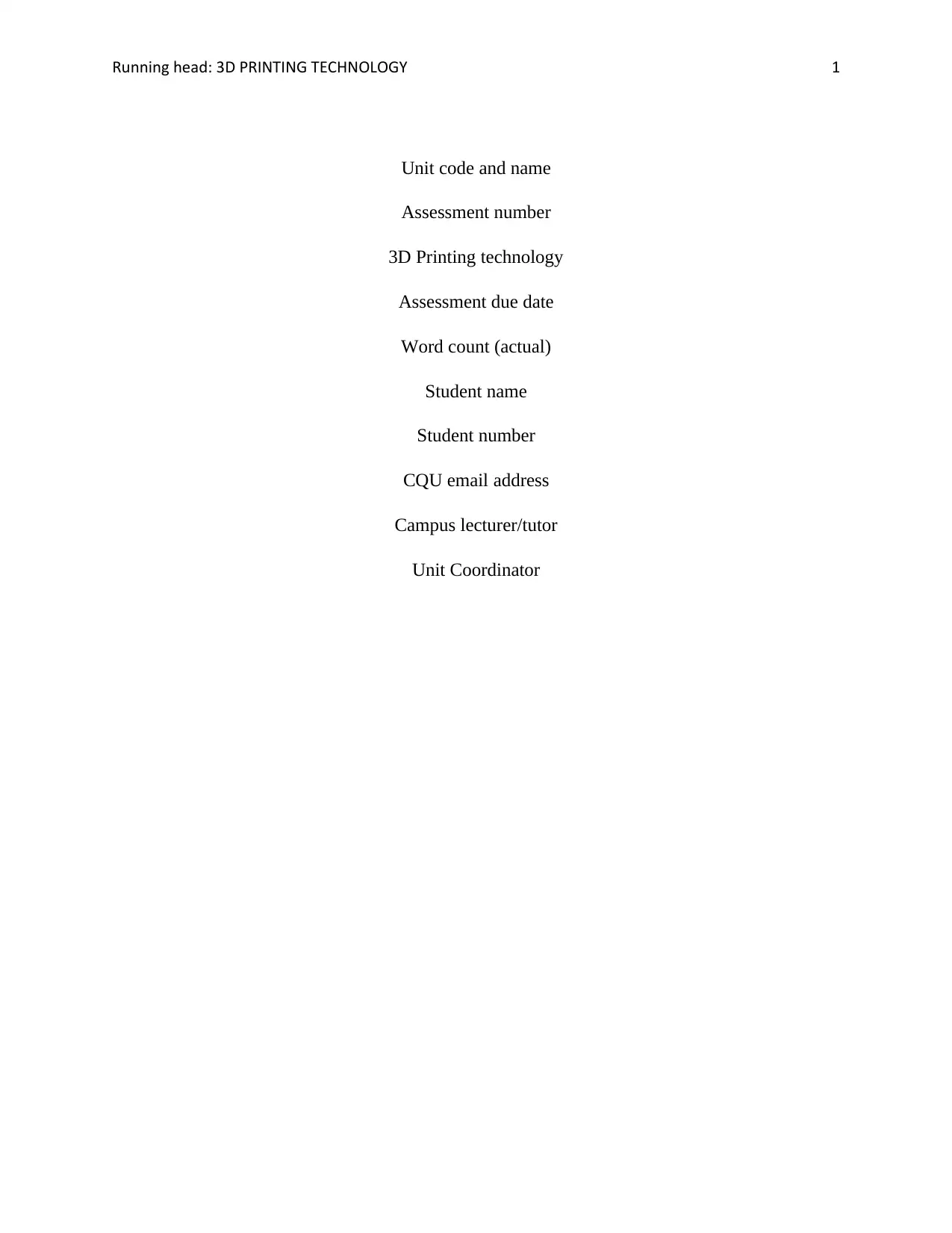
Running head: 3D PRINTING TECHNOLOGY 1
Unit code and name
Assessment number
3D Printing technology
Assessment due date
Word count (actual)
Student name
Student number
CQU email address
Campus lecturer/tutor
Unit Coordinator
Unit code and name
Assessment number
3D Printing technology
Assessment due date
Word count (actual)
Student name
Student number
CQU email address
Campus lecturer/tutor
Unit Coordinator
Paraphrase This Document
Need a fresh take? Get an instant paraphrase of this document with our AI Paraphraser
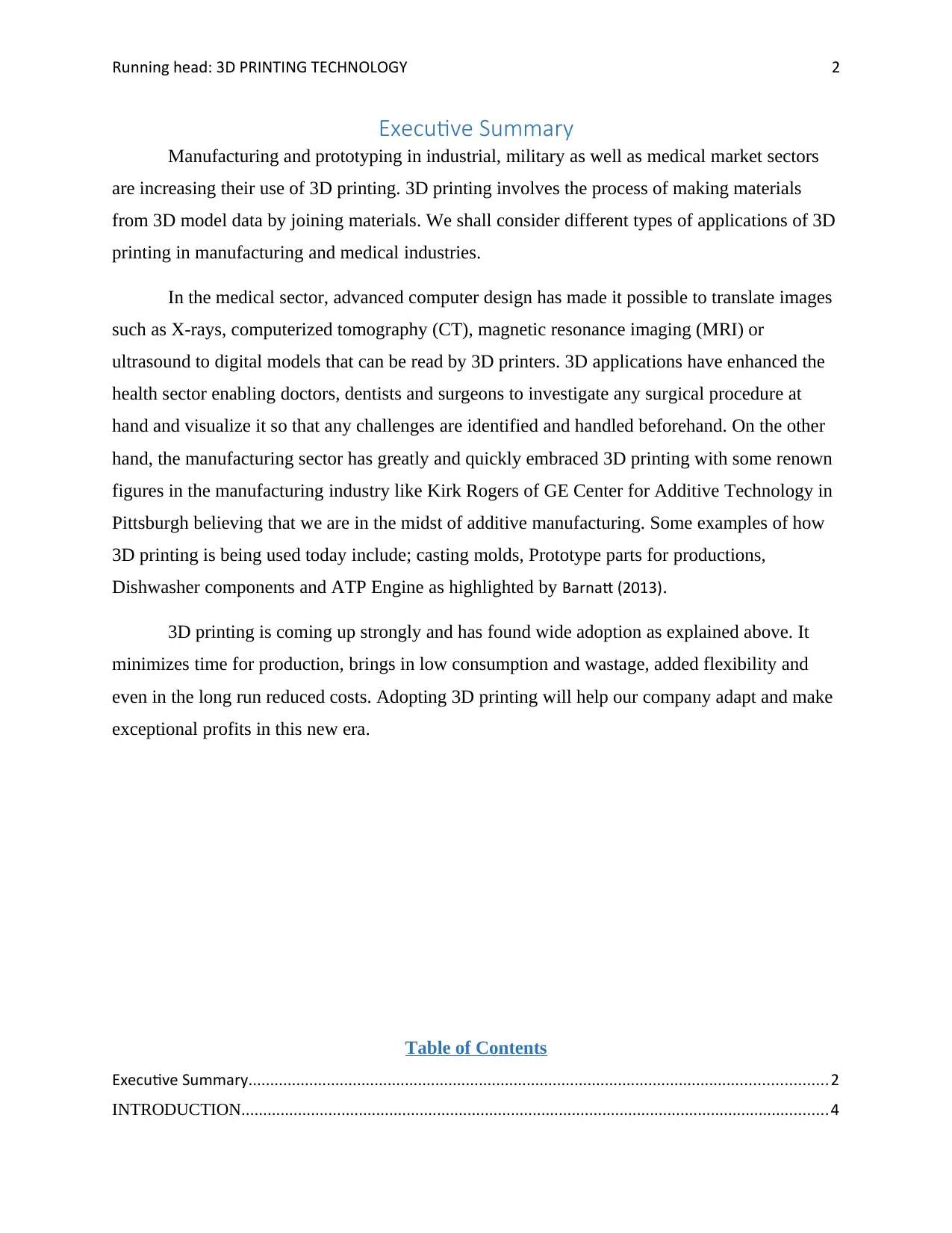
Running head: 3D PRINTING TECHNOLOGY 2
Executive Summary
Manufacturing and prototyping in industrial, military as well as medical market sectors
are increasing their use of 3D printing. 3D printing involves the process of making materials
from 3D model data by joining materials. We shall consider different types of applications of 3D
printing in manufacturing and medical industries.
In the medical sector, advanced computer design has made it possible to translate images
such as X-rays, computerized tomography (CT), magnetic resonance imaging (MRI) or
ultrasound to digital models that can be read by 3D printers. 3D applications have enhanced the
health sector enabling doctors, dentists and surgeons to investigate any surgical procedure at
hand and visualize it so that any challenges are identified and handled beforehand. On the other
hand, the manufacturing sector has greatly and quickly embraced 3D printing with some renown
figures in the manufacturing industry like Kirk Rogers of GE Center for Additive Technology in
Pittsburgh believing that we are in the midst of additive manufacturing. Some examples of how
3D printing is being used today include; casting molds, Prototype parts for productions,
Dishwasher components and ATP Engine as highlighted by Barnatt (2013).
3D printing is coming up strongly and has found wide adoption as explained above. It
minimizes time for production, brings in low consumption and wastage, added flexibility and
even in the long run reduced costs. Adopting 3D printing will help our company adapt and make
exceptional profits in this new era.
Table of Contents
Executive Summary.....................................................................................................................................2
INTRODUCTION.......................................................................................................................................4
Executive Summary
Manufacturing and prototyping in industrial, military as well as medical market sectors
are increasing their use of 3D printing. 3D printing involves the process of making materials
from 3D model data by joining materials. We shall consider different types of applications of 3D
printing in manufacturing and medical industries.
In the medical sector, advanced computer design has made it possible to translate images
such as X-rays, computerized tomography (CT), magnetic resonance imaging (MRI) or
ultrasound to digital models that can be read by 3D printers. 3D applications have enhanced the
health sector enabling doctors, dentists and surgeons to investigate any surgical procedure at
hand and visualize it so that any challenges are identified and handled beforehand. On the other
hand, the manufacturing sector has greatly and quickly embraced 3D printing with some renown
figures in the manufacturing industry like Kirk Rogers of GE Center for Additive Technology in
Pittsburgh believing that we are in the midst of additive manufacturing. Some examples of how
3D printing is being used today include; casting molds, Prototype parts for productions,
Dishwasher components and ATP Engine as highlighted by Barnatt (2013).
3D printing is coming up strongly and has found wide adoption as explained above. It
minimizes time for production, brings in low consumption and wastage, added flexibility and
even in the long run reduced costs. Adopting 3D printing will help our company adapt and make
exceptional profits in this new era.
Table of Contents
Executive Summary.....................................................................................................................................2
INTRODUCTION.......................................................................................................................................4
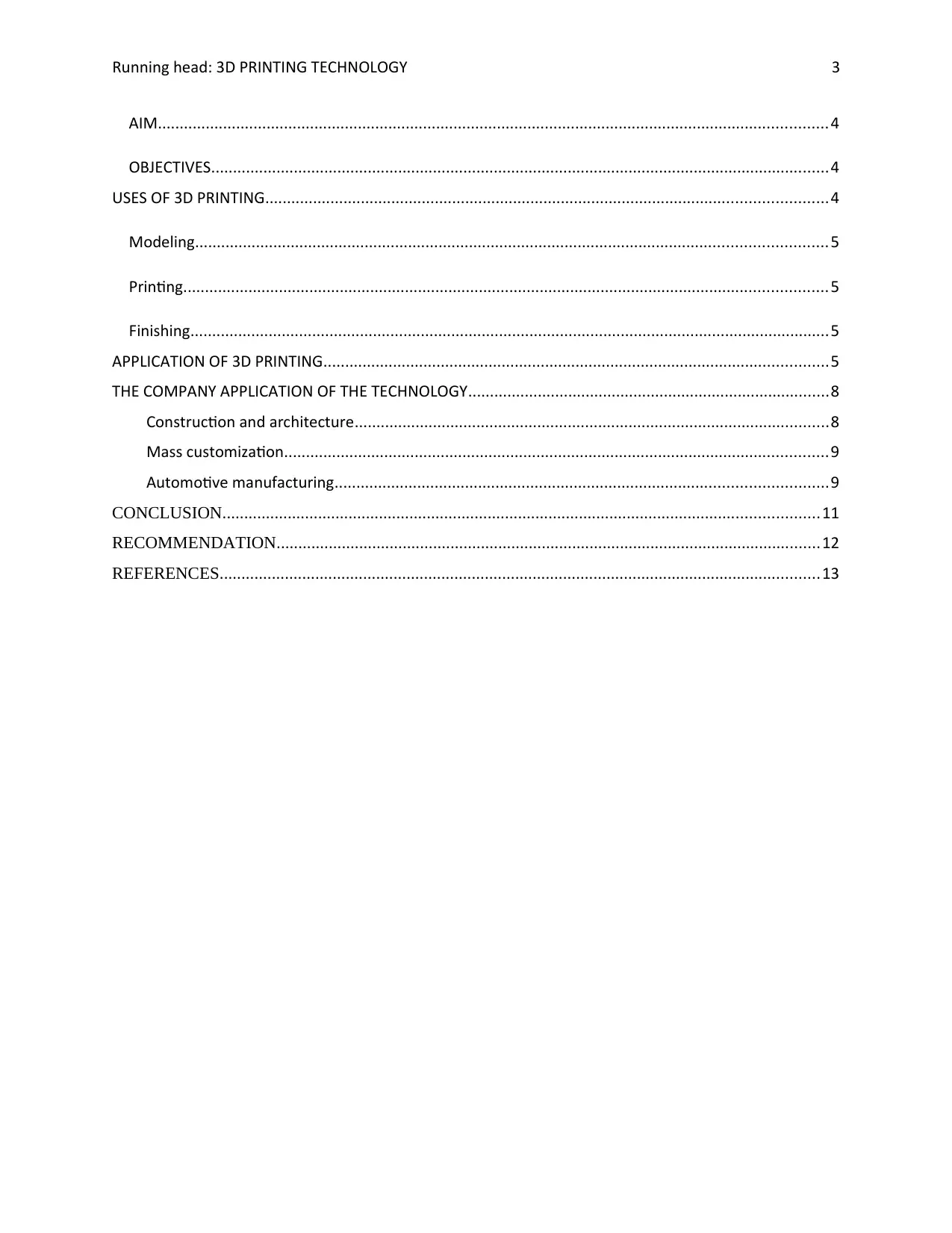
Running head: 3D PRINTING TECHNOLOGY 3
AIM..........................................................................................................................................................4
OBJECTIVES..............................................................................................................................................4
USES OF 3D PRINTING.................................................................................................................................4
Modeling.................................................................................................................................................5
Printing....................................................................................................................................................5
Finishing...................................................................................................................................................5
APPLICATION OF 3D PRINTING....................................................................................................................5
THE COMPANY APPLICATION OF THE TECHNOLOGY...................................................................................8
Construction and architecture.............................................................................................................8
Mass customization.............................................................................................................................9
Automotive manufacturing.................................................................................................................9
CONCLUSION.........................................................................................................................................11
RECOMMENDATION.............................................................................................................................12
REFERENCES..........................................................................................................................................13
AIM..........................................................................................................................................................4
OBJECTIVES..............................................................................................................................................4
USES OF 3D PRINTING.................................................................................................................................4
Modeling.................................................................................................................................................5
Printing....................................................................................................................................................5
Finishing...................................................................................................................................................5
APPLICATION OF 3D PRINTING....................................................................................................................5
THE COMPANY APPLICATION OF THE TECHNOLOGY...................................................................................8
Construction and architecture.............................................................................................................8
Mass customization.............................................................................................................................9
Automotive manufacturing.................................................................................................................9
CONCLUSION.........................................................................................................................................11
RECOMMENDATION.............................................................................................................................12
REFERENCES..........................................................................................................................................13
⊘ This is a preview!⊘
Do you want full access?
Subscribe today to unlock all pages.

Trusted by 1+ million students worldwide
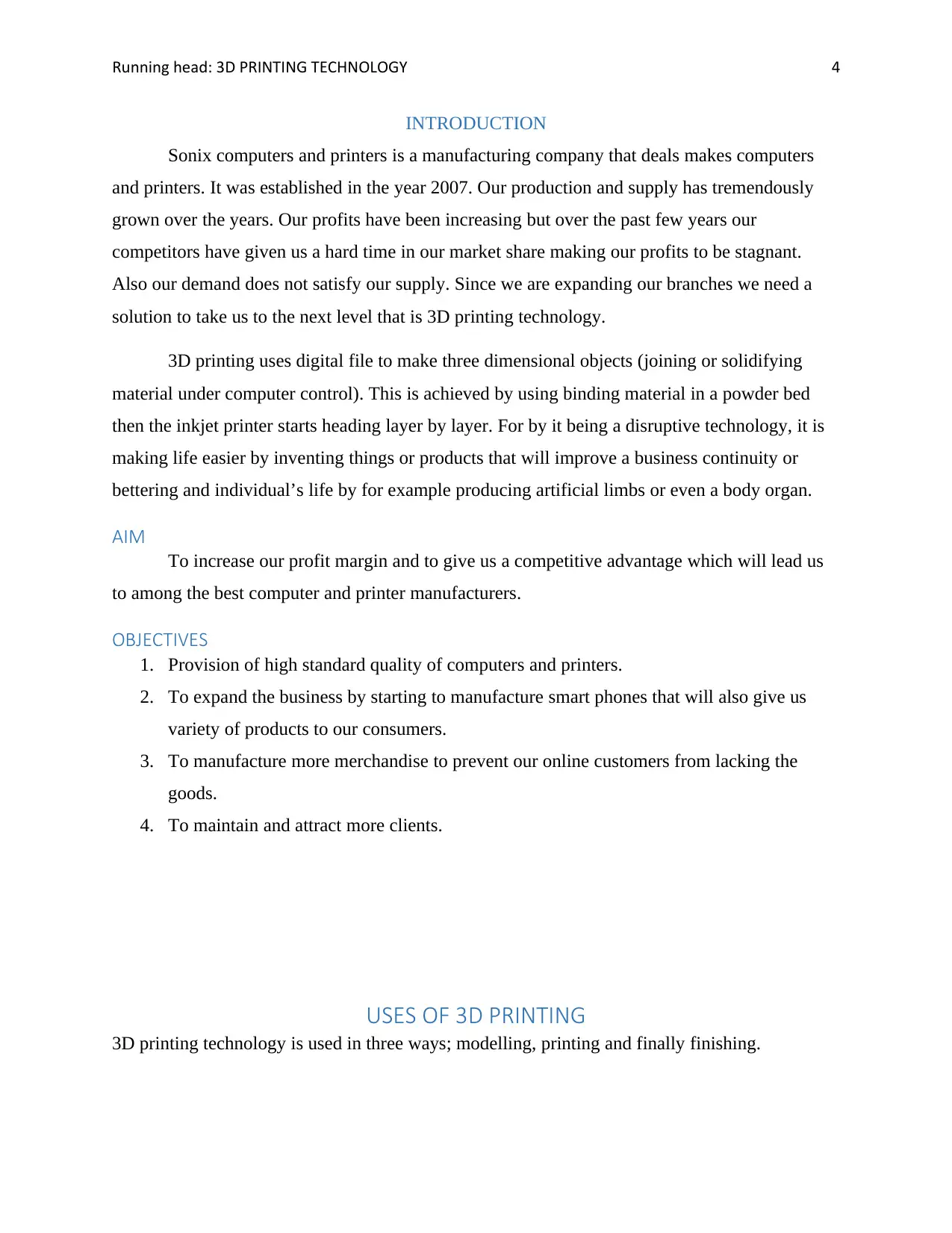
Running head: 3D PRINTING TECHNOLOGY 4
INTRODUCTION
Sonix computers and printers is a manufacturing company that deals makes computers
and printers. It was established in the year 2007. Our production and supply has tremendously
grown over the years. Our profits have been increasing but over the past few years our
competitors have given us a hard time in our market share making our profits to be stagnant.
Also our demand does not satisfy our supply. Since we are expanding our branches we need a
solution to take us to the next level that is 3D printing technology.
3D printing uses digital file to make three dimensional objects (joining or solidifying
material under computer control). This is achieved by using binding material in a powder bed
then the inkjet printer starts heading layer by layer. For by it being a disruptive technology, it is
making life easier by inventing things or products that will improve a business continuity or
bettering and individual’s life by for example producing artificial limbs or even a body organ.
AIM
To increase our profit margin and to give us a competitive advantage which will lead us
to among the best computer and printer manufacturers.
OBJECTIVES
1. Provision of high standard quality of computers and printers.
2. To expand the business by starting to manufacture smart phones that will also give us
variety of products to our consumers.
3. To manufacture more merchandise to prevent our online customers from lacking the
goods.
4. To maintain and attract more clients.
USES OF 3D PRINTING
3D printing technology is used in three ways; modelling, printing and finally finishing.
INTRODUCTION
Sonix computers and printers is a manufacturing company that deals makes computers
and printers. It was established in the year 2007. Our production and supply has tremendously
grown over the years. Our profits have been increasing but over the past few years our
competitors have given us a hard time in our market share making our profits to be stagnant.
Also our demand does not satisfy our supply. Since we are expanding our branches we need a
solution to take us to the next level that is 3D printing technology.
3D printing uses digital file to make three dimensional objects (joining or solidifying
material under computer control). This is achieved by using binding material in a powder bed
then the inkjet printer starts heading layer by layer. For by it being a disruptive technology, it is
making life easier by inventing things or products that will improve a business continuity or
bettering and individual’s life by for example producing artificial limbs or even a body organ.
AIM
To increase our profit margin and to give us a competitive advantage which will lead us
to among the best computer and printer manufacturers.
OBJECTIVES
1. Provision of high standard quality of computers and printers.
2. To expand the business by starting to manufacture smart phones that will also give us
variety of products to our consumers.
3. To manufacture more merchandise to prevent our online customers from lacking the
goods.
4. To maintain and attract more clients.
USES OF 3D PRINTING
3D printing technology is used in three ways; modelling, printing and finally finishing.
Paraphrase This Document
Need a fresh take? Get an instant paraphrase of this document with our AI Paraphraser
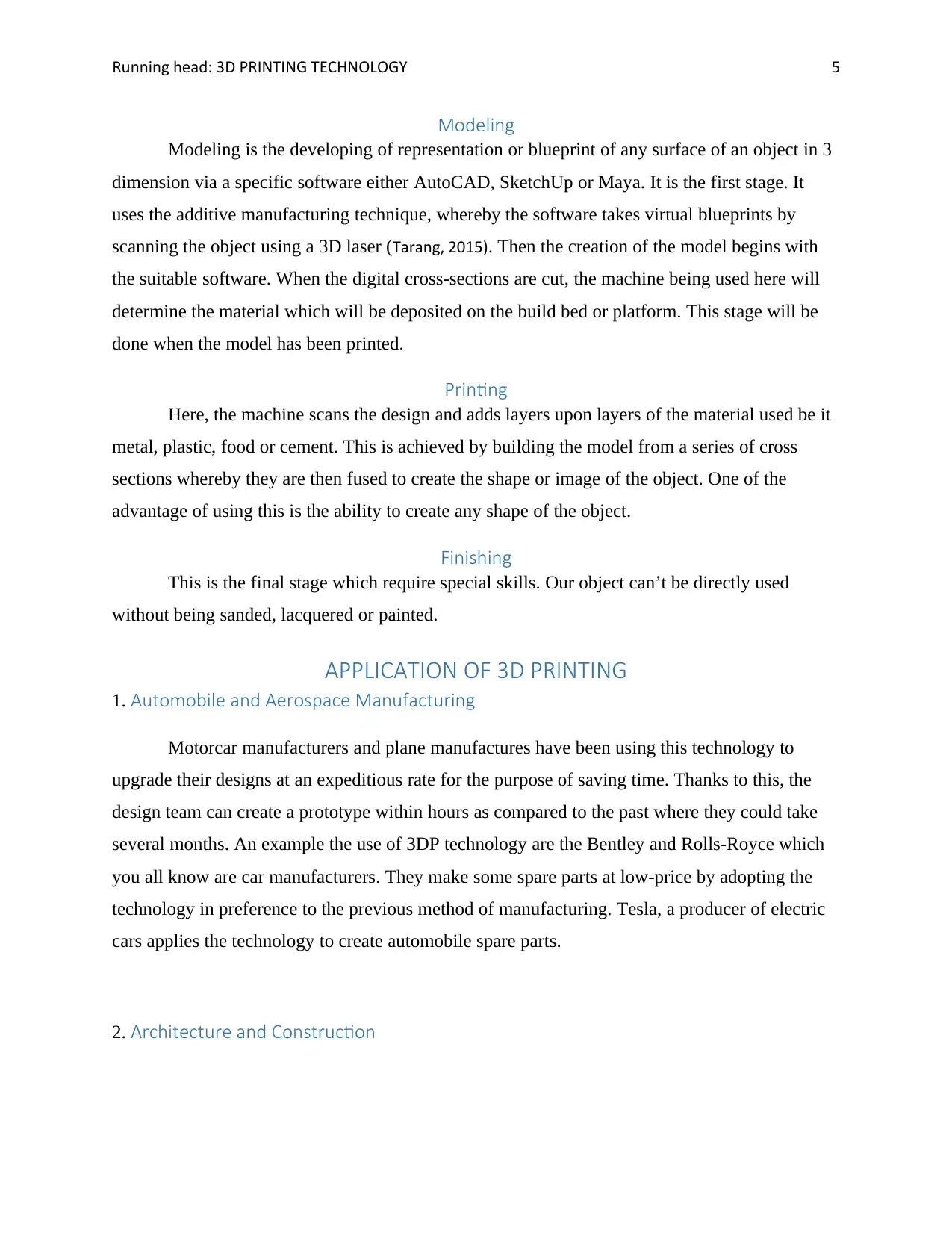
Running head: 3D PRINTING TECHNOLOGY 5
Modeling
Modeling is the developing of representation or blueprint of any surface of an object in 3
dimension via a specific software either AutoCAD, SketchUp or Maya. It is the first stage. It
uses the additive manufacturing technique, whereby the software takes virtual blueprints by
scanning the object using a 3D laser (Tarang, 2015). Then the creation of the model begins with
the suitable software. When the digital cross-sections are cut, the machine being used here will
determine the material which will be deposited on the build bed or platform. This stage will be
done when the model has been printed.
Printing
Here, the machine scans the design and adds layers upon layers of the material used be it
metal, plastic, food or cement. This is achieved by building the model from a series of cross
sections whereby they are then fused to create the shape or image of the object. One of the
advantage of using this is the ability to create any shape of the object.
Finishing
This is the final stage which require special skills. Our object can’t be directly used
without being sanded, lacquered or painted.
APPLICATION OF 3D PRINTING
1. Automobile and Aerospace Manufacturing
Motorcar manufacturers and plane manufactures have been using this technology to
upgrade their designs at an expeditious rate for the purpose of saving time. Thanks to this, the
design team can create a prototype within hours as compared to the past where they could take
several months. An example the use of 3DP technology are the Bentley and Rolls-Royce which
you all know are car manufacturers. They make some spare parts at low-price by adopting the
technology in preference to the previous method of manufacturing. Tesla, a producer of electric
cars applies the technology to create automobile spare parts.
2. Architecture and Construction
Modeling
Modeling is the developing of representation or blueprint of any surface of an object in 3
dimension via a specific software either AutoCAD, SketchUp or Maya. It is the first stage. It
uses the additive manufacturing technique, whereby the software takes virtual blueprints by
scanning the object using a 3D laser (Tarang, 2015). Then the creation of the model begins with
the suitable software. When the digital cross-sections are cut, the machine being used here will
determine the material which will be deposited on the build bed or platform. This stage will be
done when the model has been printed.
Printing
Here, the machine scans the design and adds layers upon layers of the material used be it
metal, plastic, food or cement. This is achieved by building the model from a series of cross
sections whereby they are then fused to create the shape or image of the object. One of the
advantage of using this is the ability to create any shape of the object.
Finishing
This is the final stage which require special skills. Our object can’t be directly used
without being sanded, lacquered or painted.
APPLICATION OF 3D PRINTING
1. Automobile and Aerospace Manufacturing
Motorcar manufacturers and plane manufactures have been using this technology to
upgrade their designs at an expeditious rate for the purpose of saving time. Thanks to this, the
design team can create a prototype within hours as compared to the past where they could take
several months. An example the use of 3DP technology are the Bentley and Rolls-Royce which
you all know are car manufacturers. They make some spare parts at low-price by adopting the
technology in preference to the previous method of manufacturing. Tesla, a producer of electric
cars applies the technology to create automobile spare parts.
2. Architecture and Construction
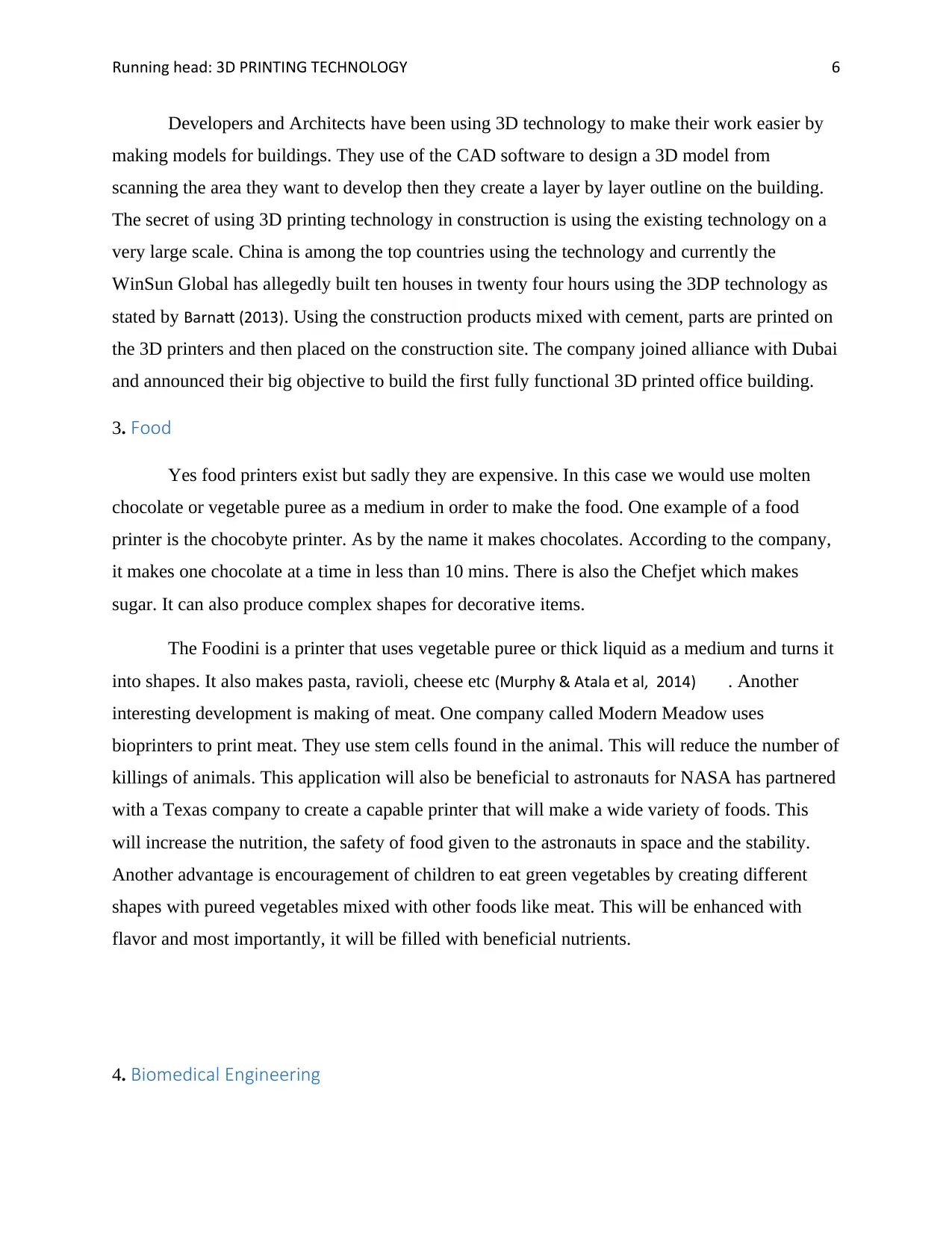
Running head: 3D PRINTING TECHNOLOGY 6
Developers and Architects have been using 3D technology to make their work easier by
making models for buildings. They use of the CAD software to design a 3D model from
scanning the area they want to develop then they create a layer by layer outline on the building.
The secret of using 3D printing technology in construction is using the existing technology on a
very large scale. China is among the top countries using the technology and currently the
WinSun Global has allegedly built ten houses in twenty four hours using the 3DP technology as
stated by Barnatt (2013). Using the construction products mixed with cement, parts are printed on
the 3D printers and then placed on the construction site. The company joined alliance with Dubai
and announced their big objective to build the first fully functional 3D printed office building.
3. Food
Yes food printers exist but sadly they are expensive. In this case we would use molten
chocolate or vegetable puree as a medium in order to make the food. One example of a food
printer is the chocobyte printer. As by the name it makes chocolates. According to the company,
it makes one chocolate at a time in less than 10 mins. There is also the Chefjet which makes
sugar. It can also produce complex shapes for decorative items.
The Foodini is a printer that uses vegetable puree or thick liquid as a medium and turns it
into shapes. It also makes pasta, ravioli, cheese etc (Murphy & Atala et al, 2014) . Another
interesting development is making of meat. One company called Modern Meadow uses
bioprinters to print meat. They use stem cells found in the animal. This will reduce the number of
killings of animals. This application will also be beneficial to astronauts for NASA has partnered
with a Texas company to create a capable printer that will make a wide variety of foods. This
will increase the nutrition, the safety of food given to the astronauts in space and the stability.
Another advantage is encouragement of children to eat green vegetables by creating different
shapes with pureed vegetables mixed with other foods like meat. This will be enhanced with
flavor and most importantly, it will be filled with beneficial nutrients.
4. Biomedical Engineering
Developers and Architects have been using 3D technology to make their work easier by
making models for buildings. They use of the CAD software to design a 3D model from
scanning the area they want to develop then they create a layer by layer outline on the building.
The secret of using 3D printing technology in construction is using the existing technology on a
very large scale. China is among the top countries using the technology and currently the
WinSun Global has allegedly built ten houses in twenty four hours using the 3DP technology as
stated by Barnatt (2013). Using the construction products mixed with cement, parts are printed on
the 3D printers and then placed on the construction site. The company joined alliance with Dubai
and announced their big objective to build the first fully functional 3D printed office building.
3. Food
Yes food printers exist but sadly they are expensive. In this case we would use molten
chocolate or vegetable puree as a medium in order to make the food. One example of a food
printer is the chocobyte printer. As by the name it makes chocolates. According to the company,
it makes one chocolate at a time in less than 10 mins. There is also the Chefjet which makes
sugar. It can also produce complex shapes for decorative items.
The Foodini is a printer that uses vegetable puree or thick liquid as a medium and turns it
into shapes. It also makes pasta, ravioli, cheese etc (Murphy & Atala et al, 2014) . Another
interesting development is making of meat. One company called Modern Meadow uses
bioprinters to print meat. They use stem cells found in the animal. This will reduce the number of
killings of animals. This application will also be beneficial to astronauts for NASA has partnered
with a Texas company to create a capable printer that will make a wide variety of foods. This
will increase the nutrition, the safety of food given to the astronauts in space and the stability.
Another advantage is encouragement of children to eat green vegetables by creating different
shapes with pureed vegetables mixed with other foods like meat. This will be enhanced with
flavor and most importantly, it will be filled with beneficial nutrients.
4. Biomedical Engineering
⊘ This is a preview!⊘
Do you want full access?
Subscribe today to unlock all pages.

Trusted by 1+ million students worldwide
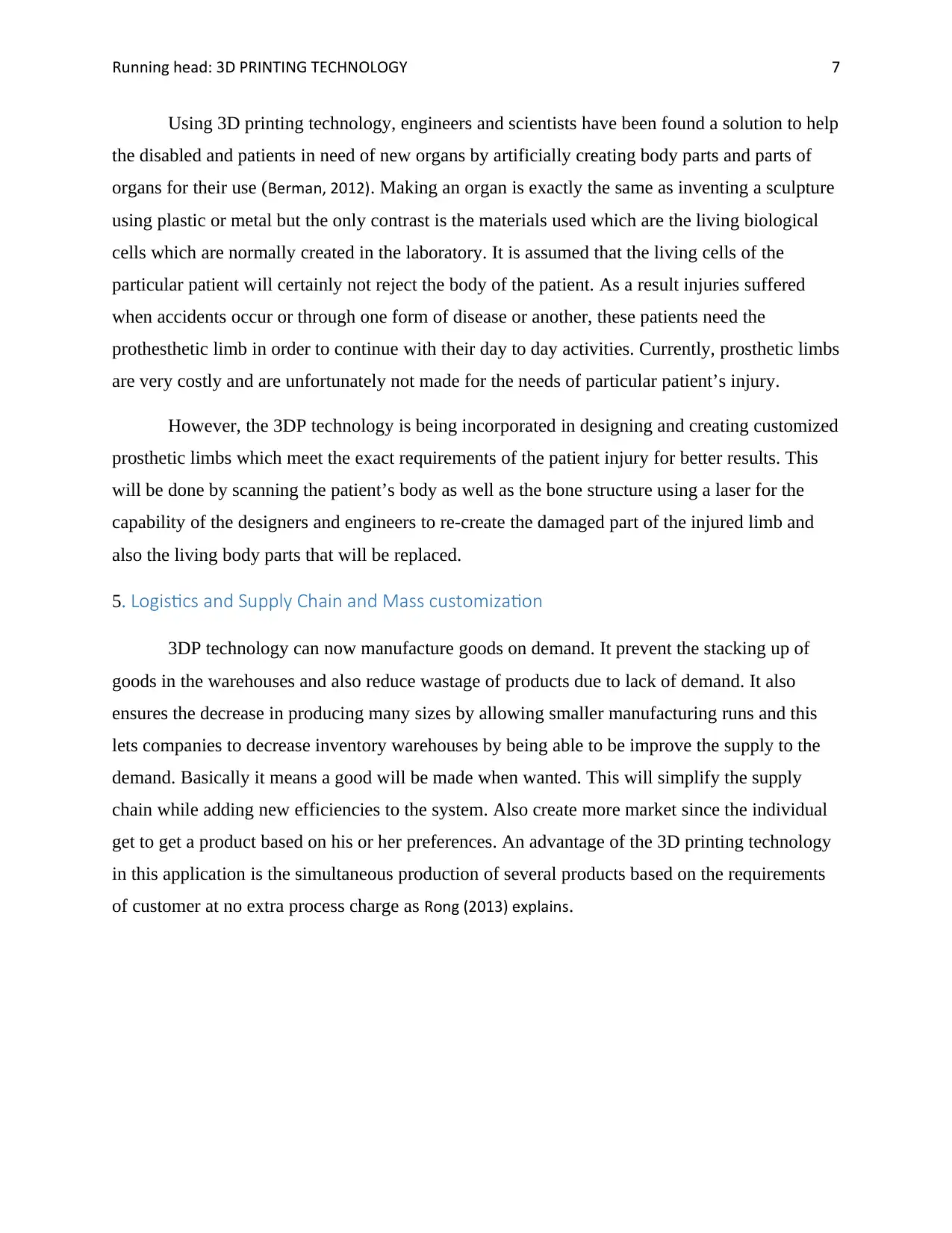
Running head: 3D PRINTING TECHNOLOGY 7
Using 3D printing technology, engineers and scientists have been found a solution to help
the disabled and patients in need of new organs by artificially creating body parts and parts of
organs for their use (Berman, 2012). Making an organ is exactly the same as inventing a sculpture
using plastic or metal but the only contrast is the materials used which are the living biological
cells which are normally created in the laboratory. It is assumed that the living cells of the
particular patient will certainly not reject the body of the patient. As a result injuries suffered
when accidents occur or through one form of disease or another, these patients need the
prothesthetic limb in order to continue with their day to day activities. Currently, prosthetic limbs
are very costly and are unfortunately not made for the needs of particular patient’s injury.
However, the 3DP technology is being incorporated in designing and creating customized
prosthetic limbs which meet the exact requirements of the patient injury for better results. This
will be done by scanning the patient’s body as well as the bone structure using a laser for the
capability of the designers and engineers to re-create the damaged part of the injured limb and
also the living body parts that will be replaced.
5. Logistics and Supply Chain and Mass customization
3DP technology can now manufacture goods on demand. It prevent the stacking up of
goods in the warehouses and also reduce wastage of products due to lack of demand. It also
ensures the decrease in producing many sizes by allowing smaller manufacturing runs and this
lets companies to decrease inventory warehouses by being able to be improve the supply to the
demand. Basically it means a good will be made when wanted. This will simplify the supply
chain while adding new efficiencies to the system. Also create more market since the individual
get to get a product based on his or her preferences. An advantage of the 3D printing technology
in this application is the simultaneous production of several products based on the requirements
of customer at no extra process charge as Rong (2013) explains.
Using 3D printing technology, engineers and scientists have been found a solution to help
the disabled and patients in need of new organs by artificially creating body parts and parts of
organs for their use (Berman, 2012). Making an organ is exactly the same as inventing a sculpture
using plastic or metal but the only contrast is the materials used which are the living biological
cells which are normally created in the laboratory. It is assumed that the living cells of the
particular patient will certainly not reject the body of the patient. As a result injuries suffered
when accidents occur or through one form of disease or another, these patients need the
prothesthetic limb in order to continue with their day to day activities. Currently, prosthetic limbs
are very costly and are unfortunately not made for the needs of particular patient’s injury.
However, the 3DP technology is being incorporated in designing and creating customized
prosthetic limbs which meet the exact requirements of the patient injury for better results. This
will be done by scanning the patient’s body as well as the bone structure using a laser for the
capability of the designers and engineers to re-create the damaged part of the injured limb and
also the living body parts that will be replaced.
5. Logistics and Supply Chain and Mass customization
3DP technology can now manufacture goods on demand. It prevent the stacking up of
goods in the warehouses and also reduce wastage of products due to lack of demand. It also
ensures the decrease in producing many sizes by allowing smaller manufacturing runs and this
lets companies to decrease inventory warehouses by being able to be improve the supply to the
demand. Basically it means a good will be made when wanted. This will simplify the supply
chain while adding new efficiencies to the system. Also create more market since the individual
get to get a product based on his or her preferences. An advantage of the 3D printing technology
in this application is the simultaneous production of several products based on the requirements
of customer at no extra process charge as Rong (2013) explains.
Paraphrase This Document
Need a fresh take? Get an instant paraphrase of this document with our AI Paraphraser
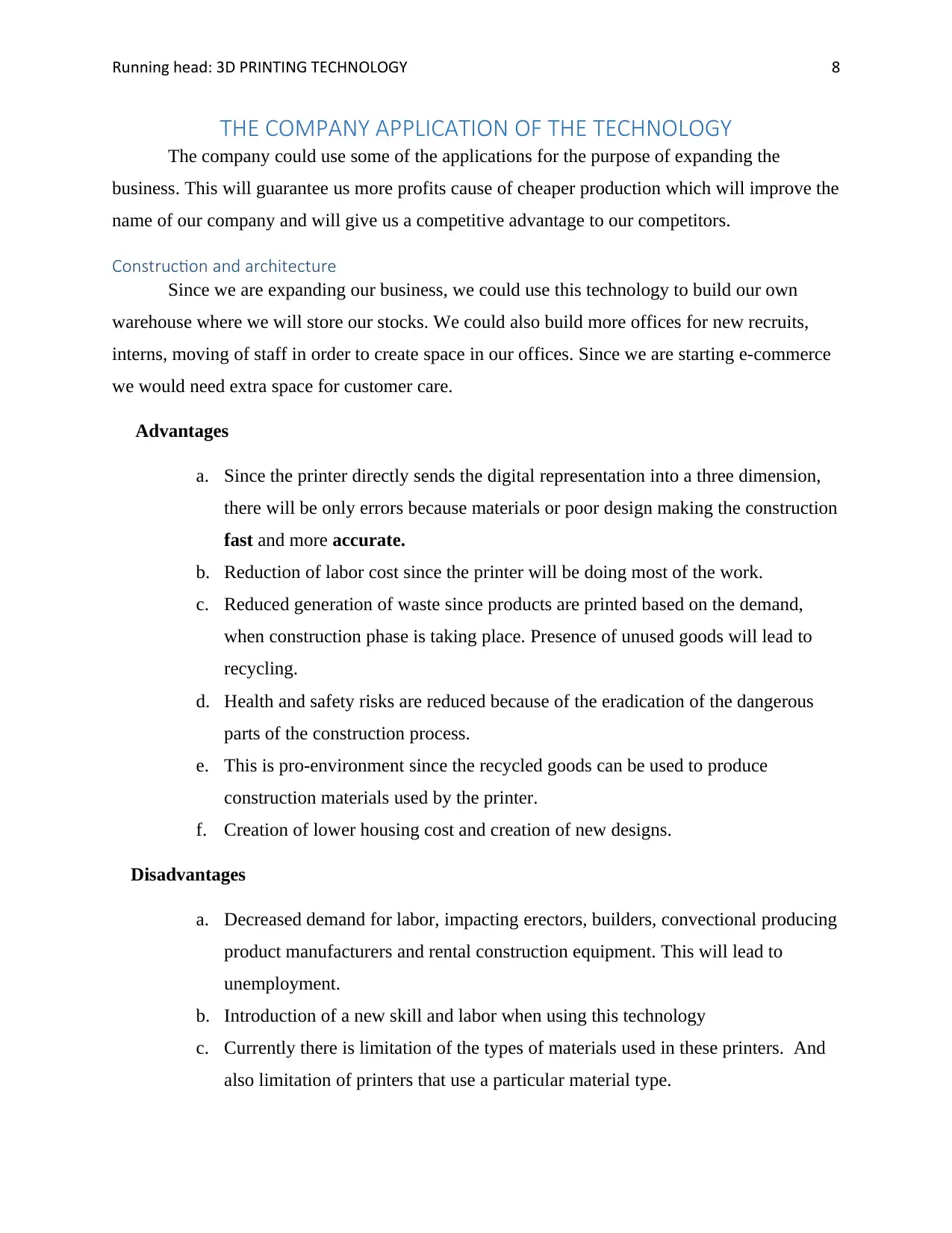
Running head: 3D PRINTING TECHNOLOGY 8
THE COMPANY APPLICATION OF THE TECHNOLOGY
The company could use some of the applications for the purpose of expanding the
business. This will guarantee us more profits cause of cheaper production which will improve the
name of our company and will give us a competitive advantage to our competitors.
Construction and architecture
Since we are expanding our business, we could use this technology to build our own
warehouse where we will store our stocks. We could also build more offices for new recruits,
interns, moving of staff in order to create space in our offices. Since we are starting e-commerce
we would need extra space for customer care.
Advantages
a. Since the printer directly sends the digital representation into a three dimension,
there will be only errors because materials or poor design making the construction
fast and more accurate.
b. Reduction of labor cost since the printer will be doing most of the work.
c. Reduced generation of waste since products are printed based on the demand,
when construction phase is taking place. Presence of unused goods will lead to
recycling.
d. Health and safety risks are reduced because of the eradication of the dangerous
parts of the construction process.
e. This is pro-environment since the recycled goods can be used to produce
construction materials used by the printer.
f. Creation of lower housing cost and creation of new designs.
Disadvantages
a. Decreased demand for labor, impacting erectors, builders, convectional producing
product manufacturers and rental construction equipment. This will lead to
unemployment.
b. Introduction of a new skill and labor when using this technology
c. Currently there is limitation of the types of materials used in these printers. And
also limitation of printers that use a particular material type.
THE COMPANY APPLICATION OF THE TECHNOLOGY
The company could use some of the applications for the purpose of expanding the
business. This will guarantee us more profits cause of cheaper production which will improve the
name of our company and will give us a competitive advantage to our competitors.
Construction and architecture
Since we are expanding our business, we could use this technology to build our own
warehouse where we will store our stocks. We could also build more offices for new recruits,
interns, moving of staff in order to create space in our offices. Since we are starting e-commerce
we would need extra space for customer care.
Advantages
a. Since the printer directly sends the digital representation into a three dimension,
there will be only errors because materials or poor design making the construction
fast and more accurate.
b. Reduction of labor cost since the printer will be doing most of the work.
c. Reduced generation of waste since products are printed based on the demand,
when construction phase is taking place. Presence of unused goods will lead to
recycling.
d. Health and safety risks are reduced because of the eradication of the dangerous
parts of the construction process.
e. This is pro-environment since the recycled goods can be used to produce
construction materials used by the printer.
f. Creation of lower housing cost and creation of new designs.
Disadvantages
a. Decreased demand for labor, impacting erectors, builders, convectional producing
product manufacturers and rental construction equipment. This will lead to
unemployment.
b. Introduction of a new skill and labor when using this technology
c. Currently there is limitation of the types of materials used in these printers. And
also limitation of printers that use a particular material type.
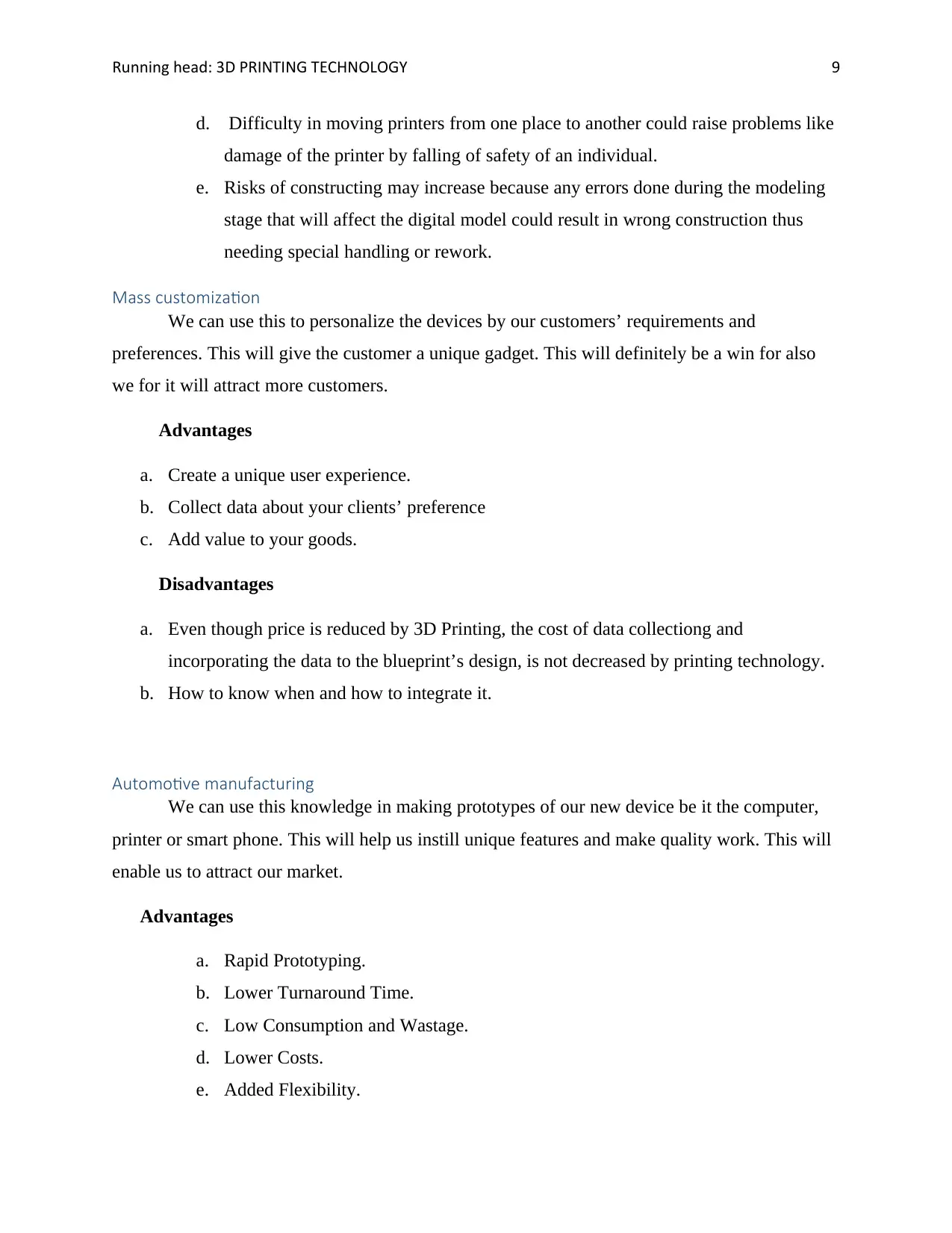
Running head: 3D PRINTING TECHNOLOGY 9
d. Difficulty in moving printers from one place to another could raise problems like
damage of the printer by falling of safety of an individual.
e. Risks of constructing may increase because any errors done during the modeling
stage that will affect the digital model could result in wrong construction thus
needing special handling or rework.
Mass customization
We can use this to personalize the devices by our customers’ requirements and
preferences. This will give the customer a unique gadget. This will definitely be a win for also
we for it will attract more customers.
Advantages
a. Create a unique user experience.
b. Collect data about your clients’ preference
c. Add value to your goods.
Disadvantages
a. Even though price is reduced by 3D Printing, the cost of data collectiong and
incorporating the data to the blueprint’s design, is not decreased by printing technology.
b. How to know when and how to integrate it.
Automotive manufacturing
We can use this knowledge in making prototypes of our new device be it the computer,
printer or smart phone. This will help us instill unique features and make quality work. This will
enable us to attract our market.
Advantages
a. Rapid Prototyping.
b. Lower Turnaround Time.
c. Low Consumption and Wastage.
d. Lower Costs.
e. Added Flexibility.
d. Difficulty in moving printers from one place to another could raise problems like
damage of the printer by falling of safety of an individual.
e. Risks of constructing may increase because any errors done during the modeling
stage that will affect the digital model could result in wrong construction thus
needing special handling or rework.
Mass customization
We can use this to personalize the devices by our customers’ requirements and
preferences. This will give the customer a unique gadget. This will definitely be a win for also
we for it will attract more customers.
Advantages
a. Create a unique user experience.
b. Collect data about your clients’ preference
c. Add value to your goods.
Disadvantages
a. Even though price is reduced by 3D Printing, the cost of data collectiong and
incorporating the data to the blueprint’s design, is not decreased by printing technology.
b. How to know when and how to integrate it.
Automotive manufacturing
We can use this knowledge in making prototypes of our new device be it the computer,
printer or smart phone. This will help us instill unique features and make quality work. This will
enable us to attract our market.
Advantages
a. Rapid Prototyping.
b. Lower Turnaround Time.
c. Low Consumption and Wastage.
d. Lower Costs.
e. Added Flexibility.
⊘ This is a preview!⊘
Do you want full access?
Subscribe today to unlock all pages.

Trusted by 1+ million students worldwide
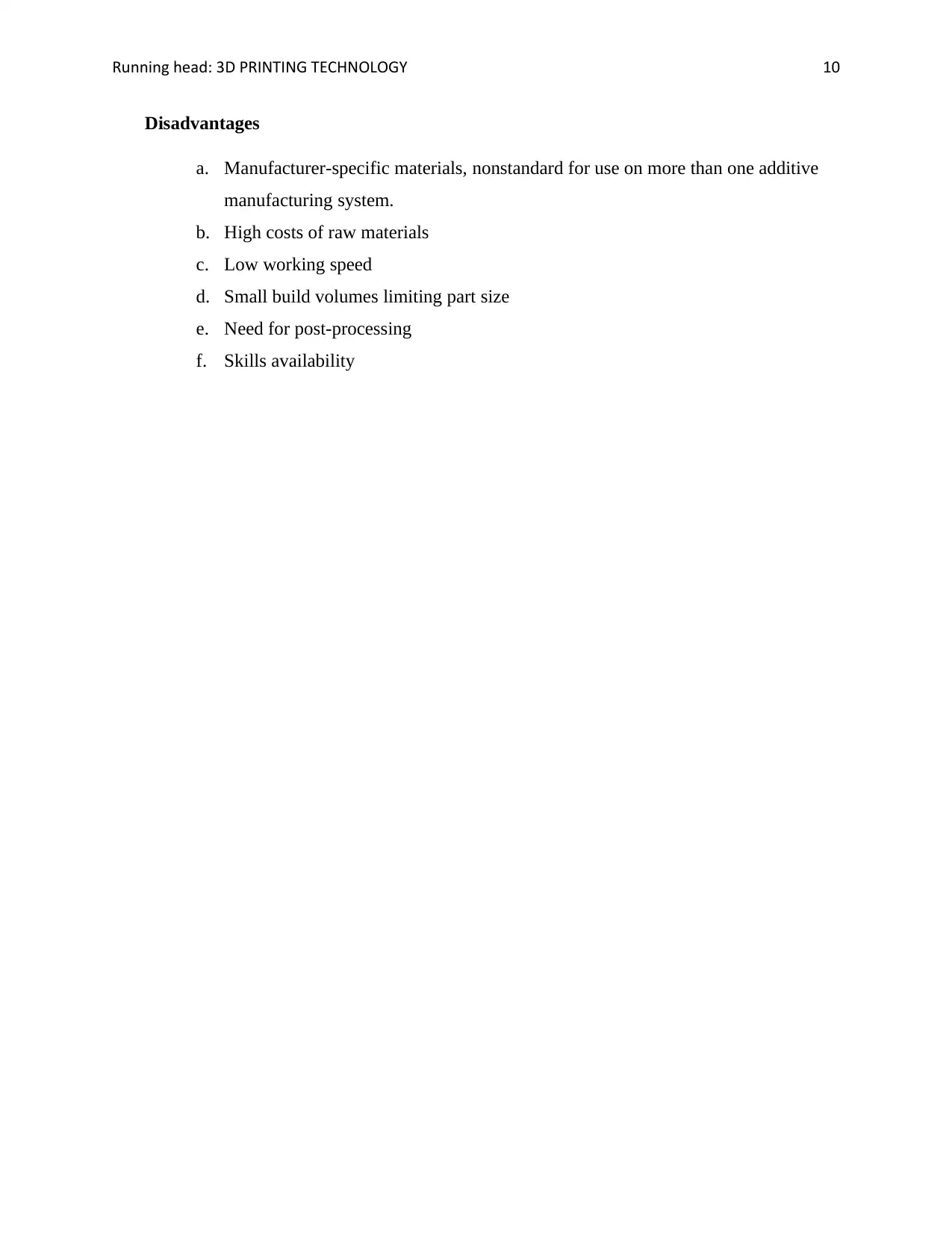
Running head: 3D PRINTING TECHNOLOGY 10
Disadvantages
a. Manufacturer-specific materials, nonstandard for use on more than one additive
manufacturing system.
b. High costs of raw materials
c. Low working speed
d. Small build volumes limiting part size
e. Need for post-processing
f. Skills availability
Disadvantages
a. Manufacturer-specific materials, nonstandard for use on more than one additive
manufacturing system.
b. High costs of raw materials
c. Low working speed
d. Small build volumes limiting part size
e. Need for post-processing
f. Skills availability
Paraphrase This Document
Need a fresh take? Get an instant paraphrase of this document with our AI Paraphraser
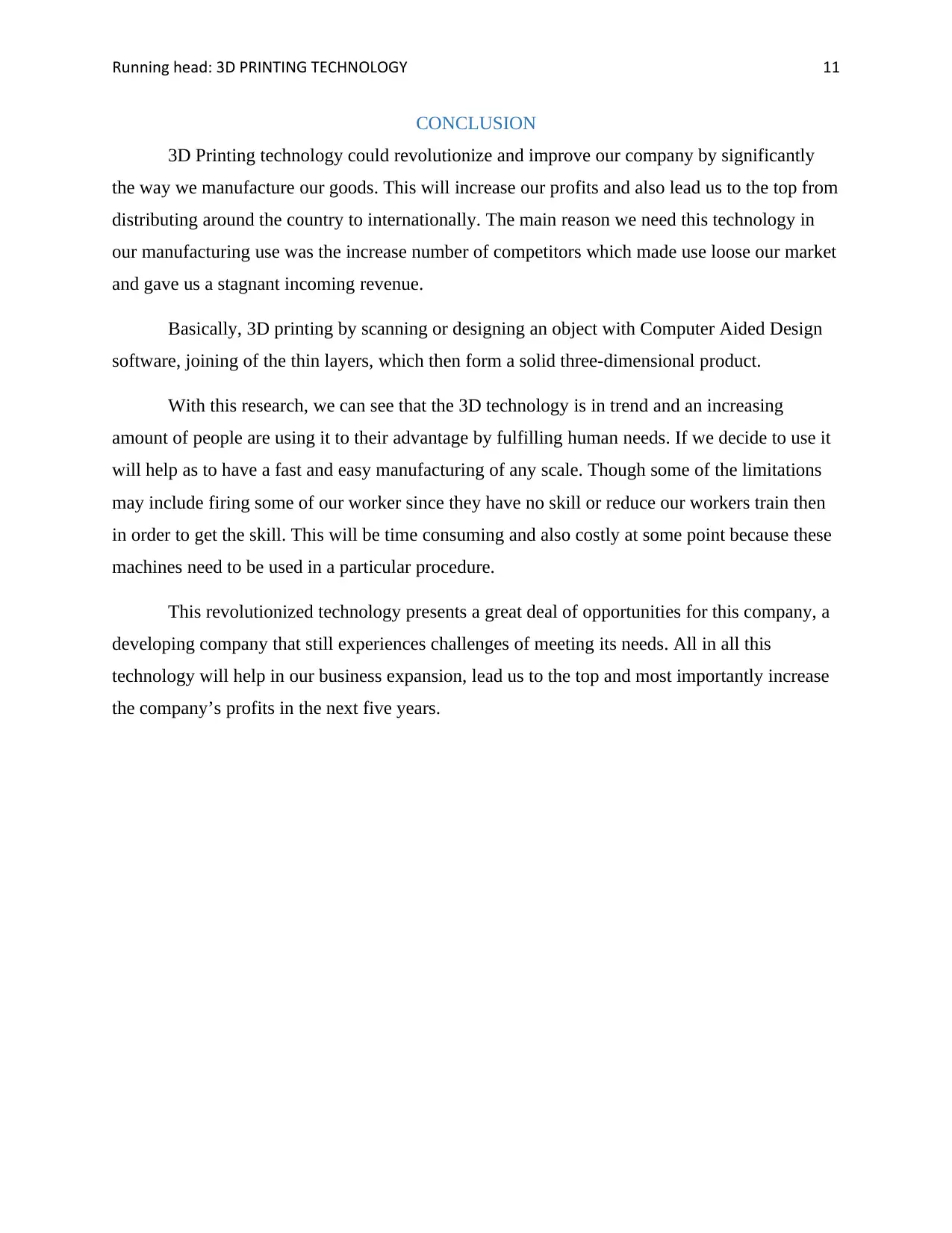
Running head: 3D PRINTING TECHNOLOGY 11
CONCLUSION
3D Printing technology could revolutionize and improve our company by significantly
the way we manufacture our goods. This will increase our profits and also lead us to the top from
distributing around the country to internationally. The main reason we need this technology in
our manufacturing use was the increase number of competitors which made use loose our market
and gave us a stagnant incoming revenue.
Basically, 3D printing by scanning or designing an object with Computer Aided Design
software, joining of the thin layers, which then form a solid three-dimensional product.
With this research, we can see that the 3D technology is in trend and an increasing
amount of people are using it to their advantage by fulfilling human needs. If we decide to use it
will help as to have a fast and easy manufacturing of any scale. Though some of the limitations
may include firing some of our worker since they have no skill or reduce our workers train then
in order to get the skill. This will be time consuming and also costly at some point because these
machines need to be used in a particular procedure.
This revolutionized technology presents a great deal of opportunities for this company, a
developing company that still experiences challenges of meeting its needs. All in all this
technology will help in our business expansion, lead us to the top and most importantly increase
the company’s profits in the next five years.
CONCLUSION
3D Printing technology could revolutionize and improve our company by significantly
the way we manufacture our goods. This will increase our profits and also lead us to the top from
distributing around the country to internationally. The main reason we need this technology in
our manufacturing use was the increase number of competitors which made use loose our market
and gave us a stagnant incoming revenue.
Basically, 3D printing by scanning or designing an object with Computer Aided Design
software, joining of the thin layers, which then form a solid three-dimensional product.
With this research, we can see that the 3D technology is in trend and an increasing
amount of people are using it to their advantage by fulfilling human needs. If we decide to use it
will help as to have a fast and easy manufacturing of any scale. Though some of the limitations
may include firing some of our worker since they have no skill or reduce our workers train then
in order to get the skill. This will be time consuming and also costly at some point because these
machines need to be used in a particular procedure.
This revolutionized technology presents a great deal of opportunities for this company, a
developing company that still experiences challenges of meeting its needs. All in all this
technology will help in our business expansion, lead us to the top and most importantly increase
the company’s profits in the next five years.
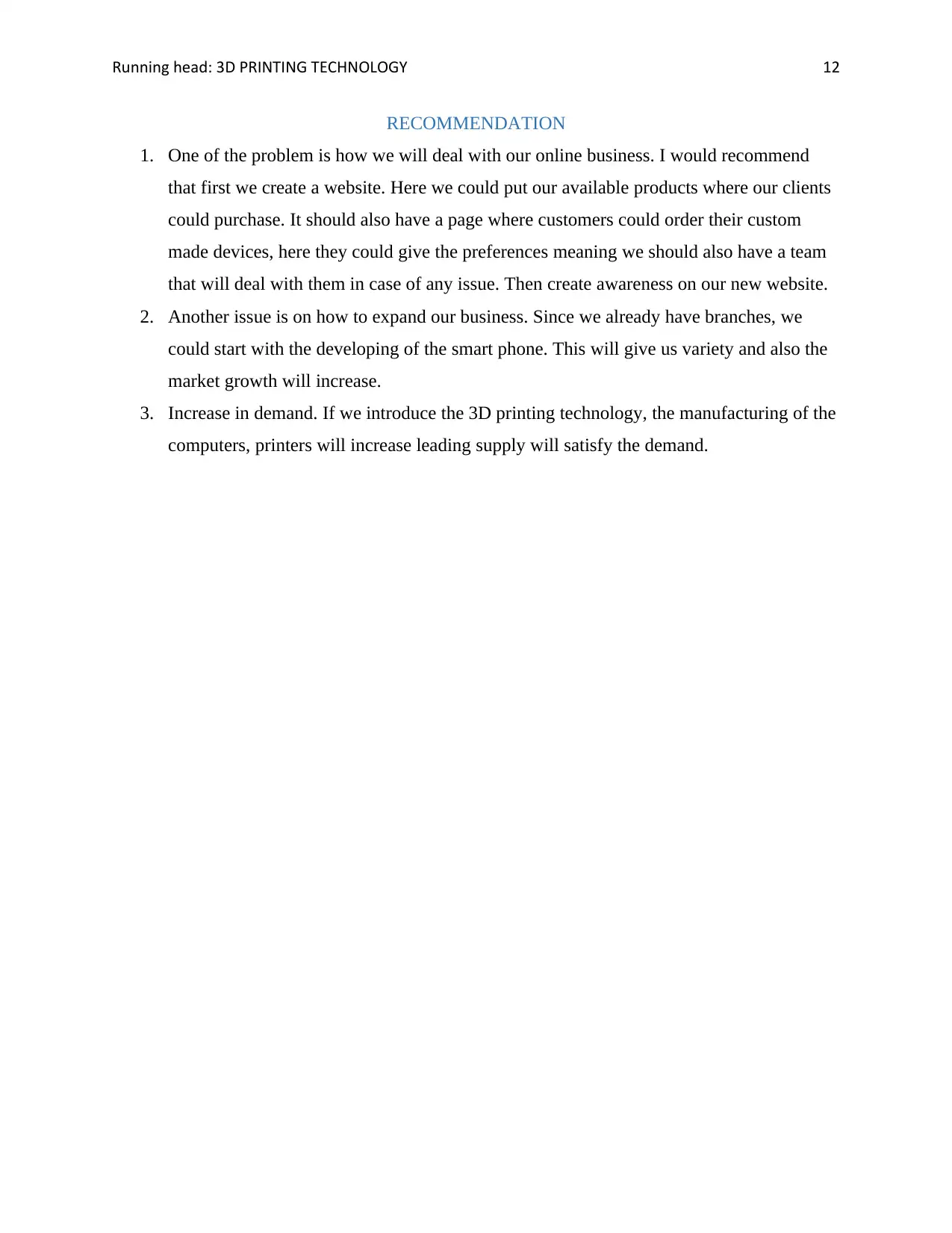
Running head: 3D PRINTING TECHNOLOGY 12
RECOMMENDATION
1. One of the problem is how we will deal with our online business. I would recommend
that first we create a website. Here we could put our available products where our clients
could purchase. It should also have a page where customers could order their custom
made devices, here they could give the preferences meaning we should also have a team
that will deal with them in case of any issue. Then create awareness on our new website.
2. Another issue is on how to expand our business. Since we already have branches, we
could start with the developing of the smart phone. This will give us variety and also the
market growth will increase.
3. Increase in demand. If we introduce the 3D printing technology, the manufacturing of the
computers, printers will increase leading supply will satisfy the demand.
RECOMMENDATION
1. One of the problem is how we will deal with our online business. I would recommend
that first we create a website. Here we could put our available products where our clients
could purchase. It should also have a page where customers could order their custom
made devices, here they could give the preferences meaning we should also have a team
that will deal with them in case of any issue. Then create awareness on our new website.
2. Another issue is on how to expand our business. Since we already have branches, we
could start with the developing of the smart phone. This will give us variety and also the
market growth will increase.
3. Increase in demand. If we introduce the 3D printing technology, the manufacturing of the
computers, printers will increase leading supply will satisfy the demand.
⊘ This is a preview!⊘
Do you want full access?
Subscribe today to unlock all pages.

Trusted by 1+ million students worldwide
1 out of 13
Related Documents
Your All-in-One AI-Powered Toolkit for Academic Success.
+13062052269
info@desklib.com
Available 24*7 on WhatsApp / Email
![[object Object]](/_next/static/media/star-bottom.7253800d.svg)
Unlock your academic potential
Copyright © 2020–2025 A2Z Services. All Rights Reserved. Developed and managed by ZUCOL.





